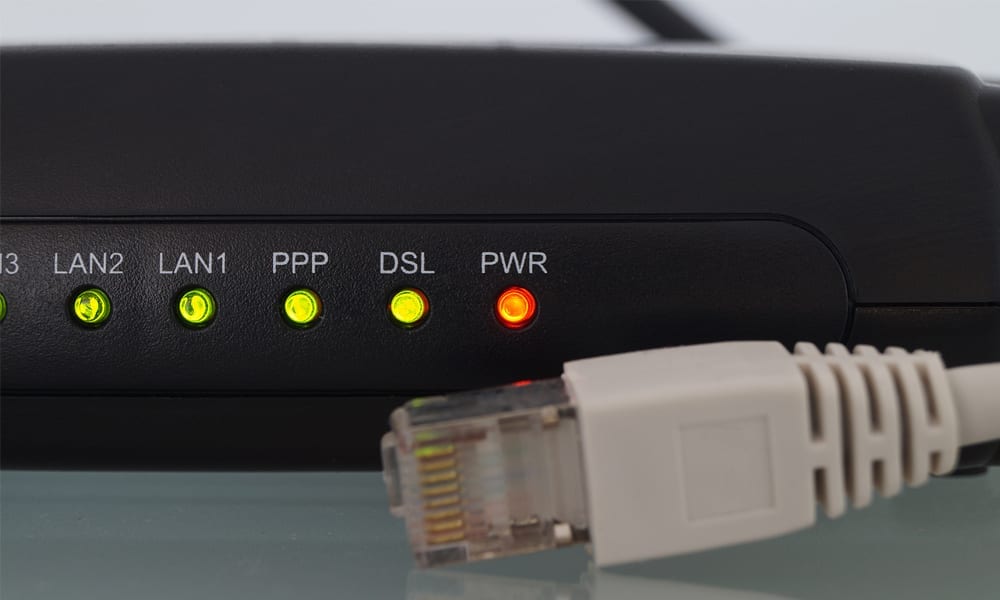Whether you use the internet to work, study, or keep in touch with loved ones, a modem is the most important device in your network. Without a modem, you won’t be able to connect to the internet at all. But what is a modem, and what does it do? Here’s everything you need to know about what a modem is, if you really need a modem and a router, and if you should buy your own modem.
What Is a Modem?
A modem is a network device that connects your local area network (LAN) to the wide area network (WAN), also known as the internet. Most modems are connected via a phone line, coaxial cable, or optical fiber.
What Does a Modem Do?
A modem “modulates and demodulates” (or converts) the analog signal from your internet service provider (ISP) and the digital signal from your router, computer, and other network devices, so you can connect to the internet.


Modems also correct data errors and control the flow and size of data that is sent to and from your network. Your modem will send data back if the information sent by your ISP doesn’t match certain values assigned to your devices. It can also tell your connected devices when to transfer data, how much data to send, and how fast data transfers will be.
Analog vs DSL vs Cable vs Fiber Optic Modems
There are several types of modems, including analog, Integrated Services Digital Network (ISDN), digital subscriber line (DSL), cable, and fiber optic. While analog, ISDN, and DSL models all use telephone lines, cable modems use a coaxial cable, and fiber optic modems use glass or plastic strands that are about as thin as a human hair.
Analog and ISDN
Analog modems only allow one data stream at a time, which means you can’t talk on the phone and surf the web at the same time. Also, analog modems are very slow and can only reach speeds up to 56 Kbps (kilobits per second). To improve on this, ISDN was developed to carry up to three data streams at the same time. With ISDN, you can get speeds up to 128 Kbps. These two “dial-up” connections are rarely used today.
DSL
DSL modems still use phone lines to transmit data, but they work on a different frequency, so you can make phone calls while you are using the internet. With DSL, you can get speeds up to 100 Mbps (megabits per second). However, these speeds are usually unachievable, and your connection will be impacted by how far you are physically located from your ISP’s nearest station. Typically, DSL connections only reach speeds between 5-50 Mbps.
If you want to know more about what good internet speed is, check out our article here.
Cable
Cable modems are faster and more reliable than DSL. While cable connections won’t be impacted by how far you are from your ISP, your connection will slow down when there are lots of subscribers using the internet at the same time in your area. Cable can support speeds up to 1 Gbps (gigabits per second), however, most users will only get 25-200 Mbps.
Cable and DSL are the most common types of modems on the market today. While cable is faster than DSL, it is also more expensive, and it is not as widely available in rural areas.
Fiber Optic
While DSL and cable both use electrical signals to transfer data, fiber optic uses light pulses. That means your connection won’t be impacted by how far away you are from your ISP or how many of your neighbors are using the internet at the same time. While most ISPs only provide fiber optic plans with speeds up to 1 Gbps, businesses can get plans that support speeds up to 10 Gbps. However, most users will only get speeds between 50-1,000 Mbps.
Fiber Optic internet service is more expensive than cable or DSL, and it has very limited availability. According to the FCC’s latest numbers, only 40% of the country has access to a fiber optic provider.
Do You Need a Modem and a Router?
You will need both a modem and a router if you want to use WiFi or connect multiple devices. Since most modems only have one LAN Ethernet port, you can only connect one computer at a time, and a modem won’t provide the same security that a router does.
A router is a network device that allows multiple devices to communicate with each other over a network. Most routers can accommodate multiple wired connections via Ethernet cables and wireless connections via WiFi. When you connect a router to your modem, it sends data through radio signals to provide WiFi access to dozens of devices at once.
If you want to know more about the difference between router and a modem, check out our previous article here.
Many ISPs today provide subscribers with a modem and a router or a modem/router combo device. While some ISPs require you to use the hardware they provide, most will let you use your own devices. If you can use your own devices, having separate devices will give you more controls and features than a combo device.
Plus, with a separate modem and router, you can replace your router as technology improves. Since modem technology doesn’t change as quickly as router technology, being able to upgrade one device at a time makes things easier.
Should You Buy Your Own Modem?
Buying your own modem can improve your internet connection and save you lots of money in the long run. The modem that your ISP rents to you might be old, and you might be paying much more in monthly fees than it’s worth.
If you’re going to buy a DSL modem, you might want to look for one that supports ADSL (asymmetric digital subscriber line) technology, which prioritizes download speeds over upload speeds. Also, look for a model that supports VDSL (very high-speed Digital Subscriber Line) technology, which can significantly boost your internet speeds.
For cable internet, you might want to look for a modem that supports DOCSIS 3.1 technology, which supports download speeds up to 1 Gbps. If you’re eager to future-proof though, you may want to consider buying one that has DOCSIS 4.0 technology, which supports speeds up to 10 Gbps.
Since fiber optic technology is still relatively new, most ISPs will require you to install their own Optical Network Terminals. While there are ways to buy your own fiber optic modem, they can be very expensive and difficult to install yourself.
If you’re planning to call your ISP regarding buying your own modem, you should expect that they will strongly discourage you from doing so. Also, remember that no matter how good your modem is, your internet will only be as fast as your plan. So, you will also have to upgrade your plan and your router if you want to get faster internet.
If you’re looking for a new router, check out our list of the best WiFi routers of 2020 here.



